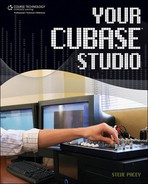Book Description
You've recently purchased Cubase. You're ready to set up your home recording studio and finally produce that album you've been talking about. Now what? Your Cubase Studio provides a complete guide to setting up your digital recording studio with Cubase so you can start recording music right away. It starts with a general introduction to Cubase and digital recording, optimizing your computer to get the best sound, purchasing the right equipment that suits your budget, and the basics of acoustics. It then moves on to provide a complete overview of the recording process, whether you're laying down the perfect vocal, guitar, and bass tracks simultaneously or separately, and how to use MIDI most effectively. You then learn to edit and mix your recording in Cubase. By the end of the book, you'll be proficient in using Cubase in a practical recording setting and ready to tackle your next recording project. Key Features: Covers home studio setup and Cubase operation-all in one book! Discusses the fundamentals of setting up and recording in a home studio Takes you way beyond the Cubase manual, teaching you how to use Cubase in a practical recording, results-focused setting Covers all iterations of Cubase 4, but is applicable to any version
Table of Contents
- Copyright
- Acknowledgments
- About the Author
- Introduction: Making Cubase Work for You
- Setting Up Cubase on Your Computer
- Accessorizing Your Cubase Studio
- Before You Record...
- Recording MIDI
- Recording Vocals
- Recording Guitar and Bass
- Recording a Whole Band or Multiple Tracks at Once
- Understanding an Analog Mixing Console
- Connecting the Sound Cards to the Mixing Console
- Hooking Up the MIDI Devices for Recording MIDI and Monitoring
- Taking Over the Closets, Living Room, and Bedroom
- Warning: Mics and Cables Everywhere! Beware of Snakes!
- Setting Up a Monitor Mix and Using a Talkback System
- Getting the Audio Signals to Cubase (Where They Belong!)
- Bypassing a Recording Console and Recording a Band
- Bypassing the Sound Card When Recording a Band
- Interfacing Your Cubase Studio with Another Pro Studio
- Understanding an Analog Mixing Console
- Basic Editing
- Mixing It Down
- Epilogue: After the Mix
